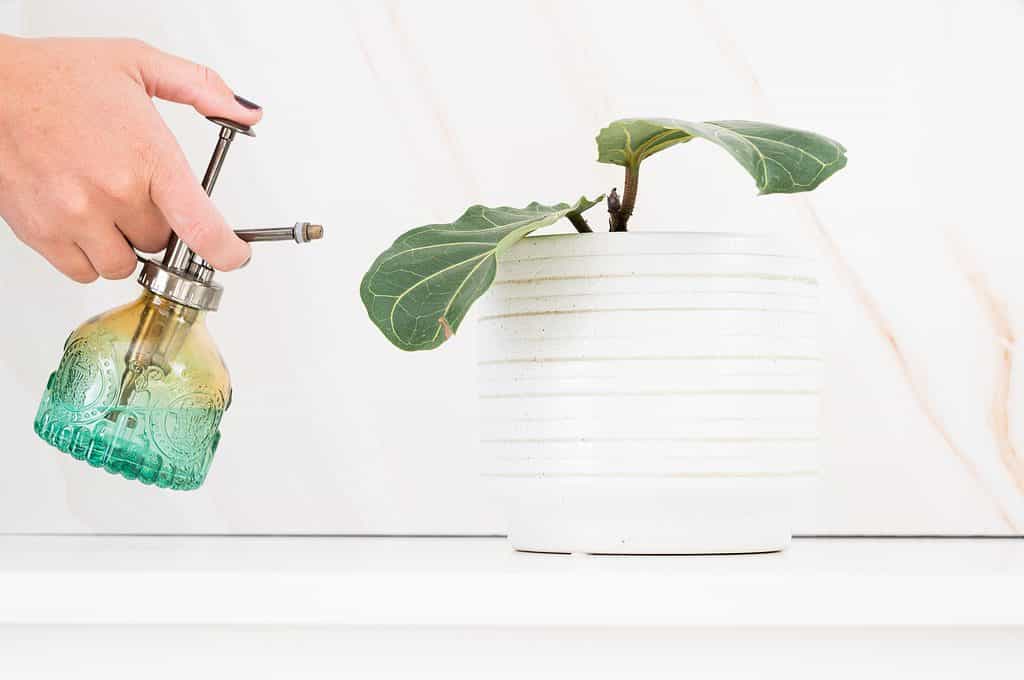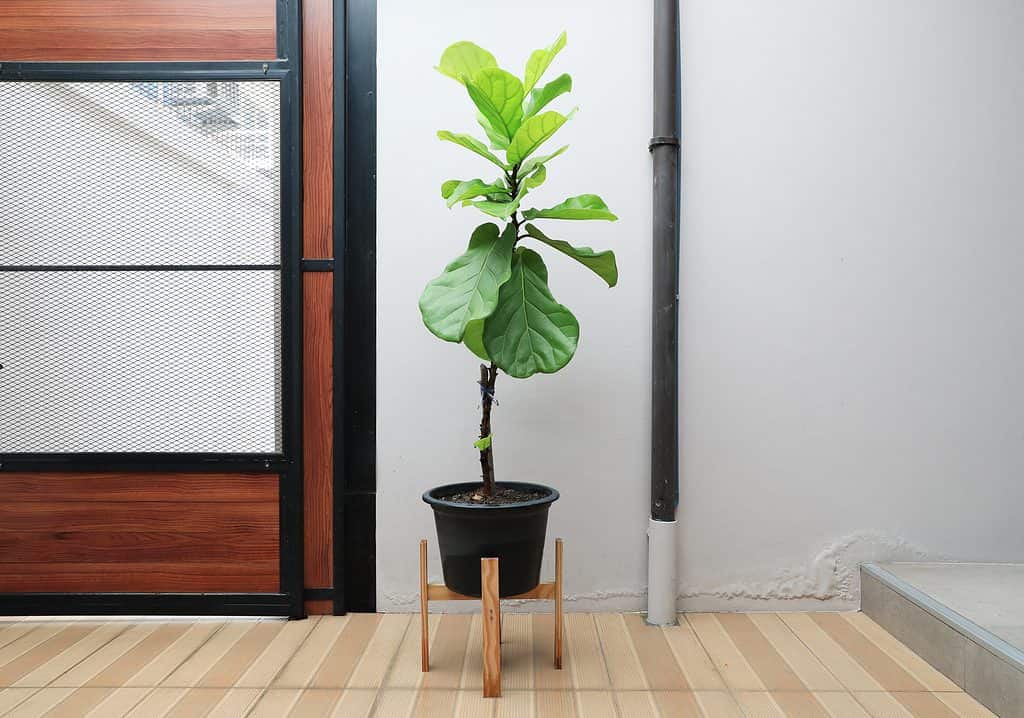Fiddle leaf fig trees (Ficus lyrata) are glossy beauties that will grow indoors or out depending on the climate. They are fairly simple to care for if you follow a few rules and try to mimic their native tropical African rainforest habitat. Here’s how to grow a large fiddle leaf fig tree indoors or out.
How Large Do Fiddle Leaf Fig Trees Get?
So what do we mean by a large fiddle leaf fig tree?
In their native environment, fiddlers grow to over 50 feet, but that won’t happen indoors! A well-cared-for houseplant fiddle leaf fig tree will reach around 10 feet.
You could just purchase a large fiddle leaf fig tree, but the problem is large plants are expensive, and it’s a worry they might not survive. Starting with a small fiddler and growing it into a large tree is a more cost-effective way of obtaining that towering lush greenery without paying over a lot of cash. Here’s how:

In their native environment, fiddlers grow to over 50 feet, but that won’t happen indoors!
©Kowit Phatipreechakul/Shutterstock.com
How to Grow a Large Fiddle Leaf Fig Indoors
Indoor fiddle leaf fig trees are hugely popular now, and they are interior designers’ dream plants. The good news is it’s possible to grow them to ceiling height.
Choosing the Right Pot
Two pots are required. The first is a liner pot that holds the soil and roots in place. It must have drainage holes and be large enough to contain all the roots, plus a couple of extra inches of growing room.
The second pot is for display purposes, so it should not have drainage holes. You need two pots to effectively water and feed your fiddler and keep the soil off the carpet.
To grow a large fiddle leaf fig indoors, repotting it every spring is necessary. This gives its roots enough space to grow and support a large green leafy stem.
When it’s time to repot, choose a new liner pot a couple of inches larger. Gently ease the fiddle leaf fig from its current pot and hold it in the center of the new one. Fill in the outer gaps with fresh new compost.
It’s also a good idea to scrape away the top few inches of soil and replace them with fresh indoor houseplant soil.
Watering and Misting a Large Indoor Fiddle Leaf Fig Tree
Indoor fiddle leaf fig trees require water only when the topsoil is drying out because consistently wet soil rots their roots.
Stick a finger into the soil. If it’s damp, check again in a few days. If it’s dry, remove the liner pot and stand it in a sink or bucket of water (rainwater is best) so it can soak up the water it needs. Then, lift it out and allow excess water to drain away before replacing it in the display pot.
If the fiddler is too large to move, add a cup of water each week (more if you see soil shrinkage), but allow the topsoil to dry out before you add more.
The frequency depends on the time of year and how hot your home is. Just use the touch-and-decide method rather than a fixed ‘Figgy Friday’ because the needs of a large indoor fiddle leaf fig tree will change over the course of a year.
Fiddlers love humidity (think steamy rainforest), so misting its magnificent leaves every few days will really give it a boost and help it to grow large in less time. Plus, removing settled dust from its foliage allows it to absorb more light and photosynthesize faster.

Misting its magnificent leaves every few days will really give it a boost and help it to grow large in less time.
©Cavan-Images/Shutterstock.com
Light Requirements
Indoor fiddle leaf fig trees need bright, indirect light to grow to epic heights.
In their natural environment, they grow beneath large rainforest trees, so they receive indirect trickles of sunlight. Mimicking this pattern will help it to grow notably larger.
Rotate it a quarter turn each week so all leaves get the same amount of sunlight. This will stop it from getting bushy on one side or leaning toward its light source.
Take some time to find the perfect spot because fiddle leaf figs are tantrum-prone and may drop leaves if they’re moved about.
Fertilizing
Use a weak houseplant fertilizer every few weeks in the growing season (the warm months), but read the instructions carefully because too much will poison it.
Temperature Preference
Fiddle-leaf fig trees like steady temperatures between 60 and 85 degrees F. Keep them away from drafts, air-conditioned spots, and radiators, or they will drop leaves.
Dealing With Indoor Pests
Usually, indoor fiddle leaf figs don’t develop pests or diseases, but there is potential for a spider mite infestation. The first sign is damaged foliage and rough brown spots. Neem oil or rubbing alcohol is a great way to get rid of spider mites without using chemicals.
If you want to grow a large indoor fiddle leaf fig tree, keeping an eye out for growth-stunting pests is important.

Fiddle-leaf fig trees like steady temperatures between 60 and 85 degrees F.
©drpnncpptak/Shutterstock.com
How to Grow a Large Fiddle Leaf Fig Outdoors
Fiddle leaf fig trees will grow outdoors to some really lofty heights. Well-cared-for fiddlers can reach 30-50 feet outside!
But not every garden is suitable for a fiddler. Here’s where they will grow and how to encourage towering growth.
Growing Zones
We already know fiddle leaf fig trees are tropical African rainforest natives, and that gives us a big clue about their preferred growing zones. In the US, fiddlers do best in USDA growing zones 9-11. So that’s California, Florida, Arizona, Louisiana, and Texas.
It’s also possible to grow them in cooler zones if you can bring them inside during cold spells.
Choosing the Best Soil
To grow really large, fiddle leaf fig trees need nutrient-rich and well-drained neutral soil. If you haven’t got those conditions, use a large container.
Ground-planted fiddlers appreciate lots of well-rotted organic matter in the planting hole and scattered around the base as mulch. This supplies them with enough fertilizer to grow tall and strong.
Light Requirements
Sun to partial sun is best for fiddle leaf fig trees. They like lots of light, but in really hot zones, the midday sun can burn their foliage. Look for a partially shaded spot that gets plenty of light.
As well as light, they also need shelter from strong winds. In their native environment, fiddle leaf fig trees are protected by large trees, so a position that provides shelter but lets in light is ideal.
If this isn’t an option, use a container and move the fiddler around as necessary.
Watering
Ground-growing fiddle leaf fig trees need water once or twice a week in hot zones or during spells of drought.
Container-grown plants need lots of water to grow large. Sunshine and wind dry out container compost quickly, so keep an eye on any container-grown plants in the warm months and water them in the evening or early morning to avoid water evaporation.
Bear in mind that even if rainfall has soaked the ground, containers prevent roots from accessing it.
Newbie figgies need water every day until they’ve established their roots. You’ll know this is happening when new growth appears.
Fertilizing
Container-grown outdoor fiddle leaf fig trees need fertilizer every few weeks in the warm growing seasons. They use up pot nutrients quickly, and when they are gone, they can’t grow any larger. In fact, they’ll turn yellow and drop leaves.
Follow the instructions carefully so you don’t accidentally give them too much. Too much fertilizer will kill them.
Fiddlers in the ground benefit from slow-release fertilizer at the start of the growing season and a thick layer of organic mulch around their roots. If your soil is poor, fertilize them every 3-4 weeks with liquid plant food.
Outdoor Pests and Diseases
Keep a close eye out for garden pests because they can have a detrimental effect on fiddle leaf fig tree growth. For example, aphids suck out their sap, and spider mites damage foliage which can lead to infections and stunted growth.
It’s best to remove pests with organic methods, if possible, like neem oil, water-infused citrus sprays, or dish soap. This encourages a strong ecosystem that benefits the surrounding environment.
Mould also interferes with growth potential, and poor circulation is usually the culprit. Cut back surrounding vegetation or prune your fiddler so air and light can reach all its foliage.

Mould also interferes with growth potential, and poor circulation is usually the culprit.
©Przemyslaw Zielinski/Shutterstock.com
Recap: How to Grow a Large Fiddle Leaf Fig Tree, Indoors or Out
Whether you are growing indoors or out, the main fiddle leaf fig tree care aspects are sufficient light, warmth, water, and nutrients, plus defense from pests or disease. If you can crack these requirements, then growing a large fiddle-leaf fig tree of soaring height is inevitable.

Fiddle leaf fig is a low-maintenance house plant.
©Jantanee Boonkhaw/Shutterstock.com
The photo featured at the top of this post is © Fajar Tri Amboro/Shutterstock.com
Thank you for reading! Have some feedback for us? Contact the AZ Animals editorial team.






